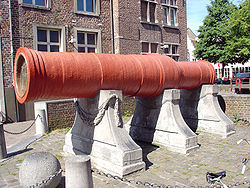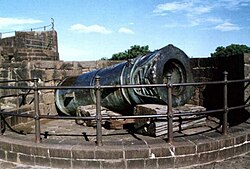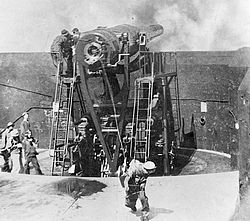| Image | Caliber (mm) | Name | Type | Produced | Place of origin | Made by | Remarks |
|---|
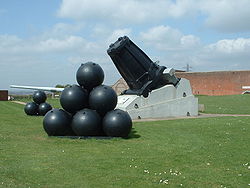 | 914 | Mallet's mortar | Mortar | 1857 |  UK UK | Robert Mallet | 2 made; a total of 19 rounds were fired in tests; never used in combat; 2 survive |
 | 914 | Little David | Mortar | 1945 |  US US | | 1 prototype made and used in testing only; the gun was fired; never used in combat; 1 survives |
 | 800 | Schwerer Gustav | Railway gun | 1941 |  Nazi Germany Nazi Germany | Krupp | 1 made (sister gun to Dora); used in combat; largest cannon in history by projectile weight; none survive |
 | 800 | Dora | Railway gun | 1942 |  Nazi Germany Nazi Germany | Krupp | 1 made (sister gun to Schwerer Gustav); unknown if used in combat; largest cannon in history by projectile weight; none survive |
 | 610 [24] [25] | Mortier monstre | Mortar | 1832 (1) and 1834 (1) |  Belgium Belgium | Henri-Joseph Paixhans | 2 made; used in combat (only one gun used during only two days of Siege of Antwerp (1832), firing about 15 shots and no other use in combat); at least 1 survives |
 | 600
(later, 540) | Karl-Gerät | Mortar | 1940 |  Nazi Germany Nazi Germany | Rheinmetall | 7 made; used in combat; one survives |
| 530 | 53 cm/52 Gerät 36 ( it ) | Naval gun (never installed to a ship) | 1941 |  Nazi Germany Nazi Germany | Krupp | 1 made; only one prototype gun made (with some secondary components never actually made); only fired experimentally; never used in combat; none survives |
 | 520 | Obusier de 520 modèle 1916 | Railway gun | 1918 |  France France | Schneider et Cie | 2 made; used in combat; none survive |
| 508 | Dahlgren smoothbore cannons, XX inch | Naval gun (never installed to a ship) | 1864 |  US US | John A. Dahlgren | 4 made; never used in combat |
 | 508 | M. 1864 20-inch Rodman gun | Naval gun (never installed to a ship) | 1864 |  US US | Thomas Jackson Rodman | 2 made (some sources say 3: 2 for Fort Hamilton in New York and third for USS Puritan); fired 8 times; never used in combat; 2 survive |
| 508 | 20 inch Perm Tsar Cannon/"Perm Giant" | | 1868 |  Russian Empire Russian Empire | Motovilikha manufacturing plant | 1 made; never used in combat; 1 survives |
 | 480 | 45 caliber 5 Year Type 36 cm gun | Naval gun (never installed to a ship) | 1918–1922 |  Empire of Japan Empire of Japan | Kure Naval Arsenal | 1 made (some sources say 2); only a prototype gun ever made; fired only experimentally; never used in battle; none survive [26] |
 | 460 | 46 cm/45 Type 94 naval gun | Naval gun | 1940 |  Empire of Japan Empire of Japan | Kure Naval Arsenal | ~27 made; used in combat (both Yamato and Musashi fired their guns against enemy only on one occasion (separate battles however)); main guns of battleships Yamato and Musashi ; the largest ever ship-installed gun by caliber; none survives |
 | 457.2 | BL 18-inch railway howitzer | Railway gun | 1920 |  UK UK | Elswick Ordnance Company | 5 made; never used in combat; one survives |
 | 457.2 | BL 18-inch Mk I naval gun | Naval gun | 1916 |  UK UK | Elswick Ordnance Company | 3 made; used in combat; the largest ever ship-installed gun by shell weight; none survives |
 | 457 | 18-inch/47-caliber Mark A gun | Naval gun (experimental; never installed to a ship) | 1942 |  US US | | [note 1] |
 | 450 | 100-ton gun (RML 17.72 inch gun) | Naval gun | 1877 |  UK UK | Elswick Ordnance Company | 15 made; fired numerous times, though never in anger; never used in combat; 2 survive |
 | 432 | 432 mm (17 in) guns | Naval gun | (?)1877 | (?) UK UK | (?)Elswick Ordnance Company | Guns installed in Italia-class ironclad and Italian ironclad Andrea Doria |
 | 420 | Big Bertha | Howitzer | 1910s |  German Empire German Empire | Krupp | 12 made; used in combat; none survive |
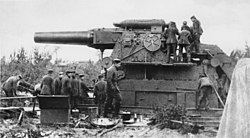 | 420 | 42 cm Gamma howitzer | Mortar | 1910s |  German Empire / German Empire /  Nazi Germany Nazi Germany | Krupp | 10 made; used in combat; no known survivors |
 | 420 | 2B1 Oka | Self-propelled artillery | 1957 |  Soviet Union Soviet Union | KBM, Kirov Plant | 4 made; never used in combat; at least one survives |
 | 420 | 42 cm Haubitze M. 14/16 | Howitzer | 1914–1918 |  Austria-Hungary Austria-Hungary | Škoda | 8 made; used in combat |
 | 412.8 | BL 16.25-inch Mk I naval gun | Naval gun | 1888 |  UK UK | Elswick Ordnance Company | 12 made; never used in combat |
 | 410 | 41 cm/45 3rd Year Type | Naval gun | 1920 |  Empire of Japan Empire of Japan | Kure and Muroran Ironworks | about 40 made; used in combat; at least 2 survive |
 | 410 | Experimental 41-cm-Howitzer | Howitzer | 1926 |  Empire of Japan Empire of Japan | Japan Steel Works | |
 | 406 | 16-inch gun M1895 | Coastal artillery | 1895 |  US US | Watervliet Arsenal | 1 made; never used in combat; none survive |
 | 406 | 16-inch/45-caliber Mark 6 gun | Naval gun | 1936 |  US US | US Navy | |
| 406 | 16-inch railway howitzer M1918 | Railway gun | 1918 |  US US | | The US Army built a one-off experimental 16-inch (406 mm) railway howitzer M1918 with some influence from the French Obusier de 400 Modèle 1915/1916 |
 | 406 | 16-inch/50-caliber M1919 gun | Coastal artillery | 1919 |  US US | Watervliet Arsenal | at least 7 made; never used in combat |
 | 406 | 16-inch howitzer M1920 | Coastal artillery | 1920 |  US US | Watervliet Arsenal | probably 5 made, 4 deployed; never used in combat; none survive |
 | 406 | 16-inch/45-caliber gun | Naval gun | 1914–1920 |  US US | Washington Navy Yard, Bethlehem Steel | 41 made |
 | 406 | 16-inch/50-caliber Mark 2 gun | Naval gun | 1917–1922 |  US US | Washington Navy Yard, Bethlehem Steel | 71 made |
 | 406 | 16-inch/50-caliber Mark 3 gun | Naval gun | |  US US | Washington Navy Yard, Bethlehem Steel | |
 | 406 | 80-ton gun (RML 16 inch gun) | Naval gun | 1874 |  UK UK | Royal Gun Factory | 8 made; used in combat; 2 survive |
| 406 | 406 mm/45 (16") Pattern 1914 [27] | Naval gun (never installed to a ship) | 1914 |  UK UK
 Russia Russia | Vickers | made in UK for Russian battleships during WW1, although the battleships in question were never built; only 1 prototype gun made and proved (gun designated by Vickers as No. 1712A); never used in battle; none survive [28] |
 | 406 (16 inch) | 16 inch conversion of a BL 18-inch Mk I naval gun | Naval gun (never installed to a ship) | 1921–1924 |  UK UK | Elswick Ordnance Company | 1 made; 16-inch conversion of a 18-inch Mk I (40 caliber) gun; an experimental gun used for prototype for the 16"/45 (40.6 cm) Mark I guns destined for the Nelson-class battleships; never used in combat (this gun was not used in combat as 18-inch gun and not used in combat after conversion into 16-inch gun); none survives [29] |
 | 406 | BL 16-inch Mk I naval gun | Naval gun | 1927 |  UK UK | | 29 made; used in combat |
| 406 | BL 16-inch Mark II naval gun [30] | Naval gun (never installed to a ship) | 1938 |  UK UK | | 2 or 3 made; never used in combat |
| 406 | BL 16-inch Mark III naval gun [30] | Naval gun (never installed to a ship) | 1938 |  UK UK | | 2 or 3 made; never used in combat |
| 406 | BL 16-inch Mark IV naval gun [30] | Naval gun (never installed to a ship) | 1943 |  UK UK | | 1 partial protype made; one BL 16-inch Mark III naval gun was converted into a partial prototype of BL 16-inch Mark IV naval gun; this partial prototype was experimentally fired; never used in combat |
 | 406 | 40.6 cm SK C/34 gun | Naval gun (never installed to a ship) | 1934 |  Nazi Germany Nazi Germany | Krupp | at least 12 made |
 | 406 | 2A3 Kondensator 2P | Self-propelled artillery | 1956 |  Soviet Union Soviet Union | KB SM, Kirov Plant | 5 made (1 prototype, 4 production); never used in combat; at least one survives |
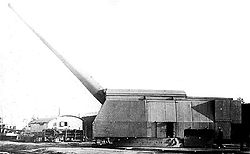 | 406 | 406 mm/50 B-37 naval gun for Sovetsky Soyuz-class battleships | Naval gun (never installed to a ship) | 1937 |  Soviet Union Soviet Union | Barrikady Plant, Stalingrad | 12 made; only one gun proof fired; the proof fired gun was used in the defense of Leningrad in WW2 as land artillery; one survives [31] |
 | 406 | 16-inch/56-caliber Mark 4 gun | Naval gun (never installed to a ship) | 1927 |  US US | | 1 made; never used in combat; one survives (although altered) [note 2] |
 | 406 | 16-inch/45-caliber Mark 6 gun | Naval gun | 1941 |  US US | Washington Navy Yard | many made for the North Carolina-class battleships and South Dakota class ships; used in combat; many survive (for example onboard museum ships North Carolina, Massachusetts and Alabama) |
 | 406 | 16-inch/50-caliber Mark 7 gun | Naval gun | 1943 |  US US | Washington Navy Yard | many made for the Iowa-class battleships; used in combat; many survive |
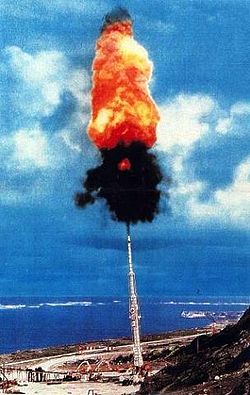 | 417 | Project HARP 16.4 inch gun | Research gun | 1962–1968 |  US US
 Canada Canada | | Repurposed American 16 inch naval guns used for high-altitude atmosphere studies. 1 made, located in Barbados; never used in combat; 1 survive |
| 406 | Project HARP 16 inch gun | Research gun | 1962–1968 |  US US
 Canada Canada | | Repurposed American 16 inch naval guns used for high-altitude atmosphere studies. 2 made, located in Highwater Range in Quebec and in the Yuma Proving Ground; never used in combat |
 | 400 | Obusier de 400 Modèle 1915/1916 | Railway gun | 1915/1916 |  France France | | 12 railway guns and 4 spare barrels (in total 16 barrels) were made; used in combat; none survive. Captured pieces known in German as 40 cm Haubitze (Eisenbahn) 752(f). |
